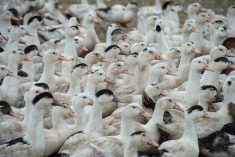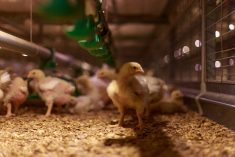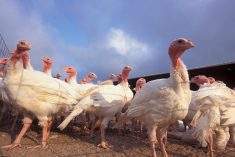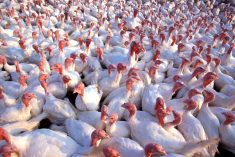Quarantines on several poultry operations in southwestern Ontario could be removed by the end of next month, assuming no new cases of avian flu turn up in the region — just in time for another notifiable poultry disease to appear.
The Feather Board Command Centre — the emergency response unit for the province’s chicken, turkey and egg marketing agencies — noted in its latest update Wednesday that no new cases of avian influenza have appeared in the province since April 23.
Field staff from the provincial “feather” boards are returning to work outside the current avian flu control zones and are limited to one farm visit per day, the FBCC said. Bans has also been lifted on visits to feather board offices and on local farmer meetings.
Read Also

U.S. grains: Wheat trades near contract lows under ample global supply
Chicago | Reuters – Chicago wheat futures ended higher on Friday, but hit their biggest weekly drop since June as…
That said, the FBCC recommended Wednesday that “broader industry meetings beyond the local level” should still be postponed until mid-June.
The region’s poultry sector has operated under “heightened biosecurity protocols” since April 7, when the first of three infected Oxford County farms — two turkey farms and a broiler breeder operation — was confirmed with H5N2 avian flu.
Farms in the two 10-kilometre control zones around the infected farms will remain at that status until the Canadian Food Inspection Agency releases them from quarantine, the FBCC said. That involves “rigorous cleaning and disinfecting protocols,” after which come testing and waiting periods.
Over a dozen farms in southern British Columbia hit with H5N2 or H5N1 avian flu earlier this year were out of quarantine by the end of March.
Under the “current schedule,” Ontario’s FBCC said, the quarantines in Oxford County could come off “by the end of June.”
ILT
The region’s poultry sector, however, may not yet be out of the woods for notifiable infectious diseases beyond avian flu.
The FBCC on Thursday reported confirmation of avian infectious laryngotracheitis (ILT) in a vaccinated commercial pullet flock in the southwestern corner of Grey County, near Hanover, Ont.
The producer had reported birds with signs of upper respiratory infection and “immediately self-quarantined” when birds showed signs of illness, the FBCC said.
It’s suspected that the illness “may be related to vaccination,” the centre said, but didn’t elaborate.
ILT, the centre said, is caused by a respiratory virus and appears mainly in laying hens and chickens. Signs of ILT include increased mortality, noisy breathing, head shaking, birds going off feed or producing fewer eggs, inactivity, ruffled feathers and conjunctivitis.
The CFIA classifies ILT as an “immediately notifiable” disease, which puts it in a list of “diseases exotic to Canada for which there are no control or eradication programs,” plus “some rare indigenous diseases.”
The CFIA can set up control measures for such diseases when notified of an outbreak, the agency said.
Canadian flocks must be certified as being free from immediately notifiable diseases, CFIA said, “in order to meet import requirements of trading partners.” –– AGCanada.com Network















